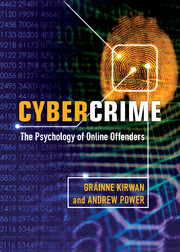Book contents
- Frontmatter
- Contents
- Detailed contents
- List of illustrations
- List of tables
- Preface
- 1 Psychology of cybercrime
- 2 Cybercrimes and cyberlaw
- 3 Hackers
- 4 Malware
- 5 Identity theft and fraud
- 6 Child predation and child pornography online
- 7 Cyberbullying and cyberstalking
- 8 Digital piracy and copyright infringement
- 9 Cyberterrorism
- 10 Crime in virtual worlds
- References
- Index
5 - Identity theft and fraud
Published online by Cambridge University Press: 05 July 2013
- Frontmatter
- Contents
- Detailed contents
- List of illustrations
- List of tables
- Preface
- 1 Psychology of cybercrime
- 2 Cybercrimes and cyberlaw
- 3 Hackers
- 4 Malware
- 5 Identity theft and fraud
- 6 Child predation and child pornography online
- 7 Cyberbullying and cyberstalking
- 8 Digital piracy and copyright infringement
- 9 Cyberterrorism
- 10 Crime in virtual worlds
- References
- Index
Summary
Case studies
Deirdre was alarmed to receive an email from her friend Steven, saying that he had been travelling abroad and had his wallet stolen. He desperately needed some cash to tide him over until he could get home, and he begged her to send him £500 to cover his expenses and pay his hotel bill. He promised to reimburse her in full once he got home. While Deirdre wasn’t particularly close to Steven, she was eager to help, and hated to see her friend in distress. She sent him the money, following the instructions in his email. A week later she rang Steven to make sure that he had got home all right, only to discover that he had no idea what she was talking about. Steven’s email account had been hacked by a fraudster, who had sent the begging email to every account in his address book.
James checked his email, and found that one of his favourite online shops had sent him a message to tell him that his account had been compromised. He needed to log in to his account immediately to check what had happened, and to avoid any more losses. James clicked on the link in the email in a panic, bringing him to the homepage of the online store, where he entered his login details. At this point an error message appeared, asking him to try again later. James emailed the online store, and waited for a response. When they responded they advised him to cancel his credit card, as it was likely that he was the victim of identity theft. The website he had entered his details on was a fake, created by fraudsters, with the intention of getting access to his account.
- Type
- Chapter
- Information
- CybercrimeThe Psychology of Online Offenders, pp. 103 - 125Publisher: Cambridge University PressPrint publication year: 2013



